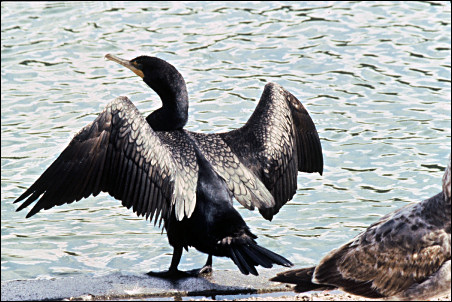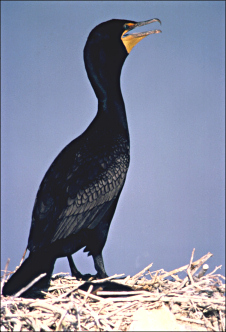
|
Context Kingdom: Animalia |
 |
Double-crested Cormorant (Phalacrocorax auritus). Photograph by Lee Karney, courtesy of the U.S. Fish and Wildlife Service. |
Length is approximately 33" and has a wingspan of 52" with an average weight of 3.7 lbs. The female is larger than the male (Sibley, 2000). This is a large dark, water bird with a long hooked bill, long tail, a long thin neck, an orange throat pouch and webbed black feet. It has orange lores and entirely black plumage. During the mating season there are small white plumes on the head (U.S. Geological Survey). Juvenile plumage is variable in color. It varies from nearly white breasted (especially in the spring) to dark brownish black (Sibley, 2000).
The double-crested cormorant lives in brackish and freshwater habitats on lakes, rivers, swamps, bays and coasts (Nature Works). They require water for feeding and nearby perches, such as rocks, sandbars, pilings, wires, trees, or docks for resting on and drying out during the day. They are common along the Texas coast (Tveten, 1993).
This species resides from southwestern Alaska and the interior of North America to the Gulf of St. Lawrence and southern Newfoundland, south to the southern United States and the Bahamas. Most of the birds in the Atlantic and Canada range in the western Gulf of St. Lawrence and on the Atlantic coast of mainland Nova Scotia. Winters from the southern parts of its summer range south to Florida and the Gulf of Mexico (Museum of Natural History).
Double-crested cormorants are opportunistic feeders on a wide variety of prey, mainly fish, but also small numbers of crustaceans, amphibians, aquatic insects, and plants (Withers and Brooks, 2004).

Double-crested Cormorant in profile. Photograph by Rodney Krey, courtesy of the U.S. Fish and Wildlife Service. |
BehaviorThe Double-crested Cormorant swims low in the water, often with just its neck and head visible, and dives from the surface. It uses its feet for propulsion and is able to dive
to a depth of 1.5–7.5 m for 30–70 seconds. After diving, it spends long periods standing with its wings outstretched to allow them to dry, since they are not fully waterproofed.
This species glides low over the water, with its bill tilted slightly upward, sometimes leaving the colony in long, single-file lines (Wikipedia.) Reproductive Characteristics
Double-crested Cormorant nestlings. Photograph by Bryan Harry, courtesy of the U.S. Park Service. Nests are built of seaweed and other coarse vegetable matter placed on a rude foundation of small sticks. These birds nest in colonies, and the sites commonly chosen are of three types: on projecting shelves on the side of steep cliffs, on level surfaces above the sea wall and preferably near its edge, and in trees 2-10 m or more in height (Museum of Natural History; Tveten, 1993). Both the male and female will build the nest and incubate the eggs for about a month (Nature Works). Laying begins in late April or early May (Museum of Natural History). The female will lay 3-4 eggs, pale blue in color and approximately 2.4" x 1.5" (Ransom, 1981). |
In the 1970s and 1980s, there was concern for the Double-crested Cormorant because of dwindling populations (Tveten, 1993). Cormorants are capable of causing considerable economic damage to catfish farms (Wither and Brooks, 2004).
Nova Scotia Museum of Natural History. Double-Crested Cormorant. Accessed 1 March 2006: http://museum.gov.ns.ca/mnh/nature/nsbirds/bns0028.htm
Nature Works. Double-Crested Cormorant Phalacrocorax auritus Accessed 27 February 2006. http://www.nhptv.org/natureworks/doublecorm.htm.
Ransom, J. E. 1981. Complete Field Guide to North American Wildlife. Harper and Row, Publishers, New York.
Sibley, D. A. 2000. The Sibley Guide to Birds. Chanticleer Press, New York.
SaltGrassFlats. Double-Crested Cormorant Phalacrocorax auritus. Accessed 1 March 2006. http://www.saltgrassflats.com/birds/cormorant_dblcrested.html.
Tveten, J. L. 1993. The Birds of Texas. Shearer Publishing, Fredericksburg, TX.
U.S. Geological Survey. Double-Crested Cormorant Phalacrocorax auritus. Accessed 27 February 2006. http://www.mbr-pwrc.usgs.gov/id/framlst/i1200id.html.
Wikipedia. Double-Crested Cormorant. Accessed 1 March 2006. http://en.wikipedia.org/wiki/Double-crested_cormorant.
Withers, K., and T. S. Brooks. 2004. Diet of Double-Crested Cormorants (Phalacrocorax auritus) wintering on the Central Texas Coast. Southwestern Naturalist, 49:48-53.